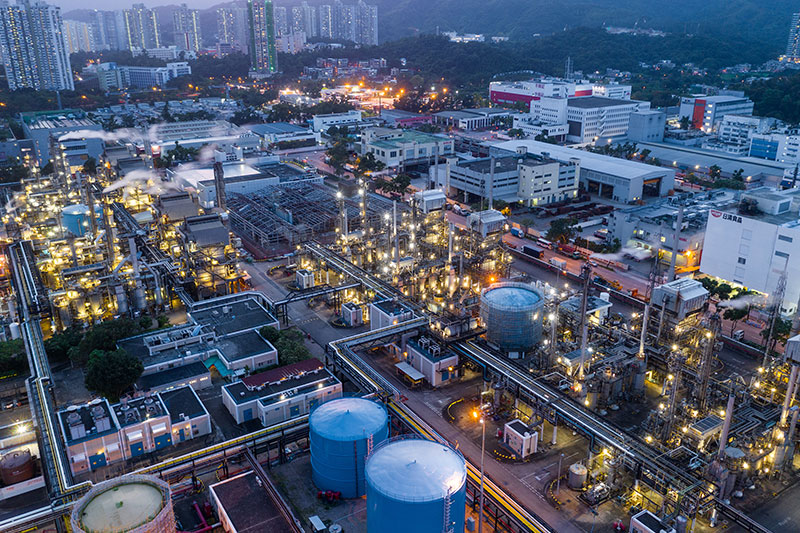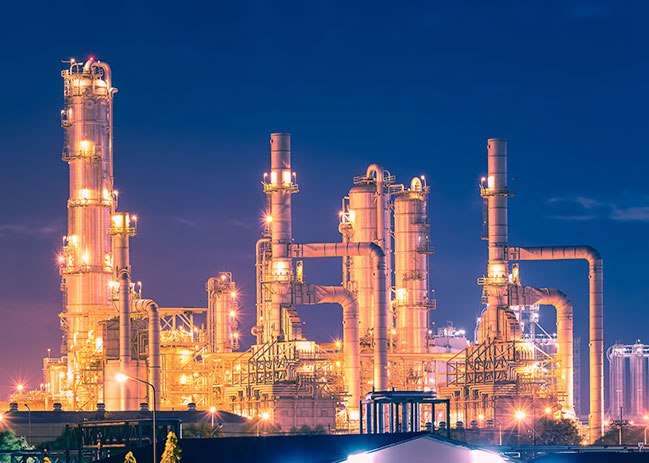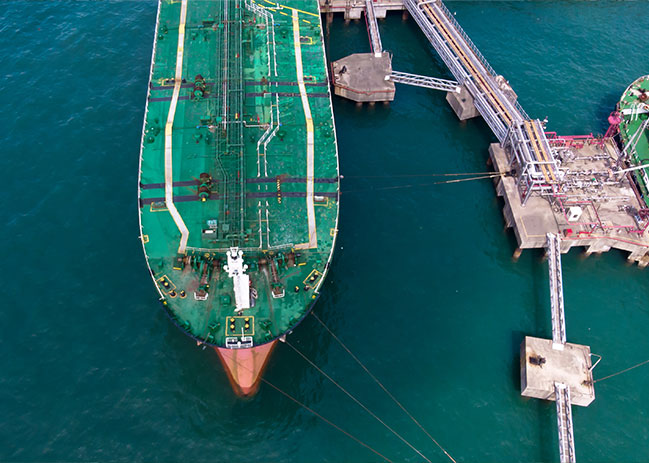
-
Petrochemicals, also called petroleum distillates
They are chemical products derived from petroleum. Some chemical compounds made from petroleum are also obtained from other fossil fuels, such as coal or natural gas, or renewable sources such as corn or sugarcane.
The two most common petrochemical classes are olefins (including ethylene and propylene) and aromatics(including benzene, toluene and xylene isomers). Oil refineries produce olefins and aromatics by fluid catalytic cracking of petroleum fractions. Chemical plants produce olefins by steam cracking of natural gas liquids like ethane and propane. Aromatics are produced by catalytic reforming of naphtha. Olefins and aromatics are the building-blocks for a wide range of materials such as solvents, detergents, and adhesives. Olefins are the basis for polymers and oligomers used in plastics, resins, fibers, elastomers, lubricants, and gels.
Global ethylene and propylene production are about 115 million tonnes and 70 million tonnes per annum, respectively. Aromatics production is approximately 70 million tonnes. The largest petrochemical industries are located in the USA and Western Europe; however, major growth in new production capacity is in the Middle East and Asia. There is substantial inter-regional petrochemical trade.
PRIMARY PETROCHEMICALS ARE DIVIDED INTO THREE GROUPS DEPENDING ON THEIR CHEMICAL STRUCTURE:
Olefins includes ethylene, propylene, and butadiene. Ethylene and propylene are important sources of industrial chemicals and plastics products. Butadiene is used in making synthetic rubber.
Aromatics includes benzene, toluene, and xylenes. Benzene is a raw material for dyes and synthetic detergents, and benzene and toluene for isocyanates MDI and TDI used in making polyurethanes. Manufacturers use xylenes to produce plastics and synthetic fibers.
Synthesis gas is a mixture of carbon monoxide and hydrogen used to make ammonia and methanol. Ammonia is used to make the fertilizer urea and methanol is used as a solvent and chemical intermediate.
The prefix “petro-” is an arbitrary abbreviation of the word “petroleum”; since “petro-” is Ancient Greek for “rock” and “oleum” means “oil”. Therefore, the etymologically correct term would be “oleochemicals”. However, the term oleochemical is used to describe chemicals derived from plant and animal fats.
From Petroleum to Petrochemicals: A Closer Look at the Industry
Petrochemical products play a crucial role in manufacturing plastics, solvents, detergents, and other materials that are essential across industries. But how exactly are these products derived from petroleum and natural gas?
At IDSM Group, we provide key insights into the world of petrochemicals – from feedstock to final product. Join us as we explore the production process, types of petrochemicals, and their applications that impact our everyday lives.
The Petrochemical Production Process
Petrochemicals begin their journey as feedstocks – raw materials derived from petroleum and natural gas. Crude oil first goes through a refining process to produce petroleum products like naphtha, ethane, propane, and butane. These hydrocarbons then become feedstocks for “cracking” – breaking large molecules into smaller ones using heat and catalysts.
Cracking transforms naphtha into light olefins like ethylene and propylene. Meanwhile, ethane cracking yields ethylene. Heavier feedstocks like propane and butane are also cracked into propylene. The resulting olefins become building blocks for many petrochemical products through processes like polymerization.
Key Types of Petrochemical Products
Olefins – Ethylene and propylene are essential olefins used to produce polymers like polyethylene and polypropylene for plastics manufacturing.
Aromatics – Benzene, toluene, and xylenes (BTX) are key aromatic compounds derived from naphtha cracking. Benzene is used to make styrene for polystyrene plastics. Toluene goes into solvents, adhesives, and nylon.
Methanol – Methanol is made by combining carbon monoxide and hydrogen. It serves as a solvent and chemical feedstock for formaldehyde, acetic acid, and more.
Ammonia – Ammonia synthesis involves reacting nitrogen and hydrogen. Ammonia is critical for fertilizers as well as plastics, fibers, and explosives.
Fueling Industries and Innovation
The versatility of petrochemicals enables their use across industries. For example, ethylene and propylene are polymerized into materials like polyethylene and polypropylene that are molded into plastic parts for automobiles, appliances, packaging, pipes, and more.
Benzene becomes a precursor for polyester fibers and nylon used in textiles. Xylene isomers are converted into PTA and DMT for polyester production. Methanol is processed into formaldehyde resins for plywood and other wood products.
Technological advances allow the petrochemical industry to create innovative products. New catalysts drive process improvements for better yields and efficiency. Emerging polymer technologies are enabling high-performance plastics for extreme conditions.
Petrochemicals in Everyday Life
Petrochemical derivatives make up the materials that surround us each day. The synthetic rubber in tires, polyurethane foam in furniture, and epoxy resins on countertops – all trace their origins back to petrochemical building blocks.
Even the clothes we wear commonly contain petroleum-based fibers like polyester, nylon, acrylic, and spandex. Plastics and other polymers derived from petrochemicals provide convenient, durable, and low-cost solutions for meeting our daily needs.
While petrochemicals bring functionality and innovation, their environmental impacts must also be managed responsibly. As global demand grows, the industry continues seeking more sustainable practices – from greener production methods to plastic recycling initiatives.
At IDSM Group, our petrochemical experts partner with clients to optimize processes and develop solutions for a changing world. Reach out to us today to learn more.
FAQs
What are petrochemical products, and how are they derived from petroleum?
Petrochemicals are chemical products like olefins, aromatics, and methanol that are obtained from petroleum and natural gas feedstocks through processes like cracking. These petrochemical building blocks are then used to manufacture plastics, resins, synthetic fibers, rubber, and more.
What are the key types of petrochemical products, and how are they used in various industries?
Major petrochemicals include olefins like ethylene and propylene, aromatics like benzene and xylenes, and methanol. These chemicals become precursors for everything from plastic packaging to polyester clothing to furniture foam.
What alternatives and sustainable practices are being explored to reduce the environmental impact of petrochemical products?
The industry is moving toward greener production methods, plastic recycling initiatives, bio-based feedstocks, and innovative biodegradable polymers to reduce the ecological footprint of petrochemicals.




